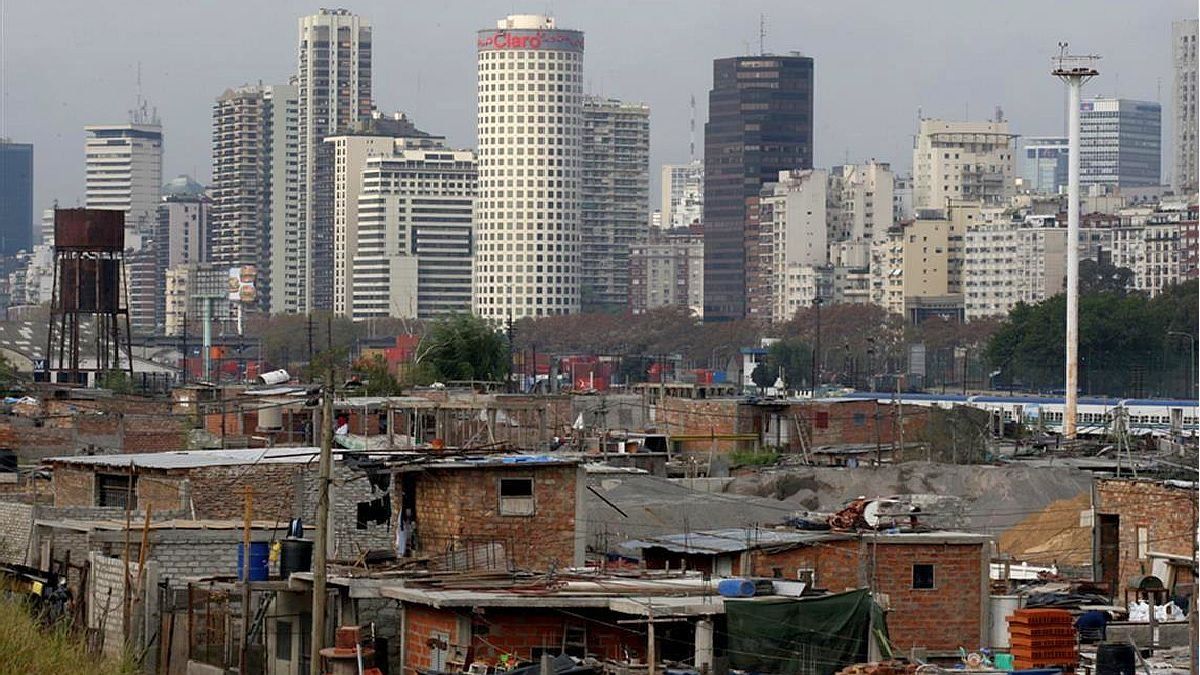https://twitter.com/ltornarolli/status/1542228616712491010
Fight among yourselves: with the income distribution data for Quarter 1 of 2022, my estimate is that the poverty rate for the moving semester October-March is significantly lower than that of Semester 2 of 2021: it falls from 37.3% to 35.2%. pic.twitter.com/6QzWCSTyHl
— Leo Tornarolli (@ltornarolli) June 29, 2022
Along the same lines, Martín Rozada, an econometrician at the Universidad Torcuato Di Tella, published that the poverty rate for the semester October 2021-March 2022 was 35.4%. Meanwhile, in the “poverty nowcast” indicator published by the university, they estimate that for the first semester of 2022 (January-June) the poverty rate was 38.4%. This is because in the first quarter it was estimated at 34.5%, but in the second quarter, at 42.4%.
The official poverty data for the first half of 2022 will be published on September 28. In the first half of 2021, poverty was 40.6%, while in the second half it dropped to 37.3%. The worst moment for this indicator in the last decade was in the second half of 2020 (July-December), when it reached 42% in the year of the pandemic.
Roberto Arias, Secretary of Tax Policies of the Ministry of Economy, considered that this drop in poverty was due to higher production and employment. “Poverty continues to decline and we are already below the level that Mauricio Macri left behind. Despite the pandemic and the sharp increase in food prices due to the war in Europe. There is a long way to go, but this is the way. More production and more employment equals less poverty”, he wrote on his twitter, sharing Tornarolli del Cedlas estimates.
To confirm or correct the estimates, Tornarolli awaits the publication of the micro data from the EPH Indec that will be published on August 4. With the highest inflation in the second quarter of 2022 (April-May-June), the poverty rate could be somewhere between 35-40%.
Asked by Ámbito about what factors could have explained a drop in poverty at the beginning of 2022, in a context of high inflation, the Cedlas researcher explained: “There was an increase in the income of the informal workers above what the baskets grew of poverty in the last year. Although the baskets began to grow above inflation in particular since March, in the rest of the period of the last 12 months of last year a process was accumulated where the opposite happened.
On the other hand, added the employment factor. “Employment, particularly salaried employment, is at the highest value in the series since 2016, and although it is low-quality employment that is not desirable, it helps reduce poverty because, to a large extent, the labor income of the most vulnerable, and from the lower part of the distribution, comes from informal work, so to the extent that there is more informal work, there are more income earners in those households,” added Tornarolli. In the first quarter, 390 thousand informal jobs were created.
https://twitter.com/MartinGRozada/status/1542255491103035397
[NOWCAST DE POBREZA ACTUALIZACION] The total family income distribution data for 1Q2022 published today suggest that the poverty rate for the semester Oct21Mar22 would be 35.4% with a 95% CI [33.8%, 37.0%] versus the 38.6% projected in April. https://t.co/oNej2pLt1R
– Martin Rozada (@MartinGRozada) June 29, 2022
In fact, the latest employment data from the Indec labor market shows that the Unemployment fell to 7%, with informal employment at a record 35.9% for the first quarter of 2022. In addition, in the income distribution data it was observed that the lowest deciles (1 and 2) grew in real terms above 10% year-on-year, according to the consulting firm LCG, “sustained from social assistance”. In any case, they expect that the acceleration of inflation will have a greater impact on the income of the poorest households, which can “hardly” be compensated with greater social assistance in a context of “limited access to spending financing.”
less activity
The poverty data for the first half of the year will be marked by what happened in this second quarter (April-May-June). “In this period you no longer have the Christmas bonus effect and there is higher inflation, but the parity and the injection of the bonus of $18,000 to 8 million people have an impact. The question is whether the improvement in the labor market can be sustained with the economy running at another speed.analyzed Santiago Poy, a researcher at the UCA’s Social Debt Observatory.
Although economic activity grew 0.6% per month in April (latest data from Indec), private projections already show a slowdown for May (-1.2%, according to OJF), which could deepen with restrictions on imports. “The best predictor for poverty in the medium term is economic activity”Poy added. In the consulting firm LCG they project that the activity will begin to retract in the coming months, which “will put a brake on the recovery of the labor market.”
Source: Ambito
David William is a talented author who has made a name for himself in the world of writing. He is a professional author who writes on a wide range of topics, from general interest to opinion news. David is currently working as a writer at 24 hours worlds where he brings his unique perspective and in-depth research to his articles, making them both informative and engaging.




